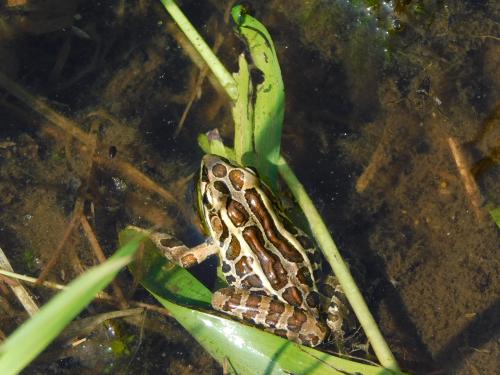
Scientific name: Lithobates palustris
Mi’kmaq Translation: To be Confirmed
French Translation: Grenouille des marais
Gaelic Translation: Gead-losgann
Physical Description
Pickerel Frogs are olive green to brown. They are spotted with irregular rectangular brown spots in two rows. Their total number of spots ranges from 7 to 21. They have white bellies with orange on the groin and underside of the back legs. The orange underside is developed with age. Their hind legs have dark bands and webbed toes. The front legs are unwebbed. Newly hatched tadpoles (larvae) are legless with long tails. The tadpoles are brown to olive green with yellow sides and black and yellow spots. The Pickerel Frog call is a low-pitched snore, very similar to that of the Northern Leopard Frog.
Size
Newly developed young range from 2.5 to 2.9 cm in length
Adult males range from 4.9 to 6.5cm in length
Adult females range from 5.1 to 7.5cm in length
Range and Distribution
Pickerel Frogs can be found from southern Ontario east to Quebec and the Maritime Provinces. In Nova Scotia, they are found in all regions of the mainland and Cape Breton.
Habitat
These frogs are common along streams and lakeshores. They often forage in grassy-sedge woods, in meadows and in fields. Pickerel Frogs can be found sharing land habitats with Northern Leopard Frogs. They can also be found sharing aquatic habitats, like wetlands and ponds, with Mink Frogs, where they prefer plenty of vegetation. They can be found quite a distance from water but require permanent water bodies for hibernation.
Diet
Pickerel Frogs prefer a diet of insects, spiders and small invertebrates. Favorites’ include ants, beetles, moth larvae and other bugs.
Reproduction and Life Cycle
Pickerel Frogs emerge from hibernation in the spring. They are typically active between April and October. Breeding season happens in May, and a process called amplexus is used. This is when the male uses his front leg to grab the females' body, causing her to release the eggs, which are fertilized externally. Breeding males can be recognized from females by the swollen base of the thumbs on their front legs. Females release a jelly-like mass containing up to 3000 brown and yellow eggs. The mass is attached to aquatic plants up to 10cm below the water's surface. Depending on water temperature, the eggs will hatch in one to three weeks. Tadpoles (larvae) develop quickly and begin growing in adult frogs in August and early September. Sexual maturity is reached after two years. Although unconfirmed, it is thought that their lifespan is no longer than five years.
Status
NSESA: Not at risk
COSEWIC:
Threats
The loss of wooded, wetland and shoreline habitats pose significant threats to Pickerel Frogs. Other factors like climate change, pollution, road mortality, and the use of the herbicides and pesticides also pose long-term health risks for these frogs.